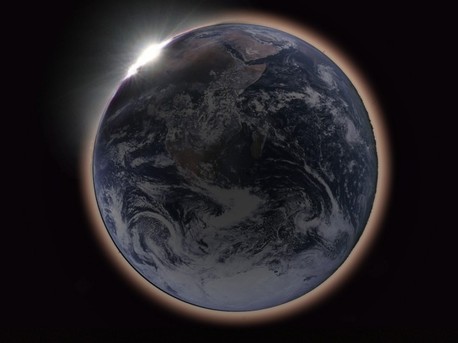Eclipses
What happens on the moon during a solar eclipse?
 © APOD/ Hana Gartstein |
If you travel to the Moon's near side, you could see a lunar eclipse as a solar eclipse, with the disk of our fair planet Earth completely blocking out the Sun. For a moon-based observer's view, graphic artist Hana Gartstein (Haifa, Israel) offers this composite illustration. In the cropped version of her picture, an Apollo 17 image of Earth is surrounded with a red-tinted haze as sunlight streams through the planet's dusty atmosphere. Earth's night side remains faintly visible, still illuminated by the dark, reddened Moon, but the disk of the Earth would appear almost four times the size of the Sun's disk, so the faint corona surrounding the Sun would be largely obscured. At the upper left, the Sun itself is just disappearing behind the Earth's limb.
Lunar eclipses are governed by the same principle as solar eclipses: In this case however, the Earth 'slides itself' between the Moon and the Sun. At these points, the Sun, Earth and Moon are arranged in an almost straight line, and the core shadow or 'umbra' of the Earth passes over the surface of the Moon. Due to the fact that the diameter of the Earth is about 4 times greater than the diameter of the Moon, the shadow cast by Earth is also about 4 times larger. As a consequence, the period of darkness on the surface of the Moon is correspondingly longer.
Lunar eclipse on Earth = solar eclipse on the Moon
If at the time of a lunar eclipse, astronauts were to be on the Moon, they would not actually experience total darkness – due to the refraction of light in the Earth’s atmosphere, for most of any lunar eclipse the Moon would be bathed in a reddish light. However, those astronauts would experience a second spectacle: A solar eclipse caused by the Earth – the Sun disappearing behind the dark disc of the Earth. When Earth inhabitants witness a lunar eclipse, Moon inhabitants would, simultaneously be witnessing a solar eclipse.
German Aerospace Center
Eclipses
What happens on the moon during a solar eclipse?
 © APOD/ Hana Gartstein |
If you travel to the Moon's near side, you could see a lunar eclipse as a solar eclipse, with the disk of our fair planet Earth completely blocking out the Sun. For a moon-based observer's view, graphic artist Hana Gartstein (Haifa, Israel) offers this composite illustration. In the cropped version of her picture, an Apollo 17 image of Earth is surrounded with a red-tinted haze as sunlight streams through the planet's dusty atmosphere. Earth's night side remains faintly visible, still illuminated by the dark, reddened Moon, but the disk of the Earth would appear almost four times the size of the Sun's disk, so the faint corona surrounding the Sun would be largely obscured. At the upper left, the Sun itself is just disappearing behind the Earth's limb.
Lunar eclipses are governed by the same principle as solar eclipses: In this case however, the Earth 'slides itself' between the Moon and the Sun. At these points, the Sun, Earth and Moon are arranged in an almost straight line, and the core shadow or 'umbra' of the Earth passes over the surface of the Moon. Due to the fact that the diameter of the Earth is about 4 times greater than the diameter of the Moon, the shadow cast by Earth is also about 4 times larger. As a consequence, the period of darkness on the surface of the Moon is correspondingly longer.
Lunar eclipse on Earth = solar eclipse on the Moon
If at the time of a lunar eclipse, astronauts were to be on the Moon, they would not actually experience total darkness – due to the refraction of light in the Earth’s atmosphere, for most of any lunar eclipse the Moon would be bathed in a reddish light. However, those astronauts would experience a second spectacle: A solar eclipse caused by the Earth – the Sun disappearing behind the dark disc of the Earth. When Earth inhabitants witness a lunar eclipse, Moon inhabitants would, simultaneously be witnessing a solar eclipse.
German Aerospace Center





